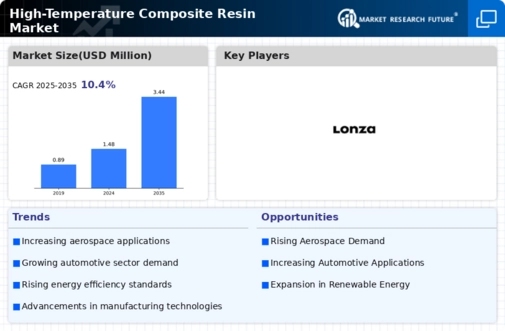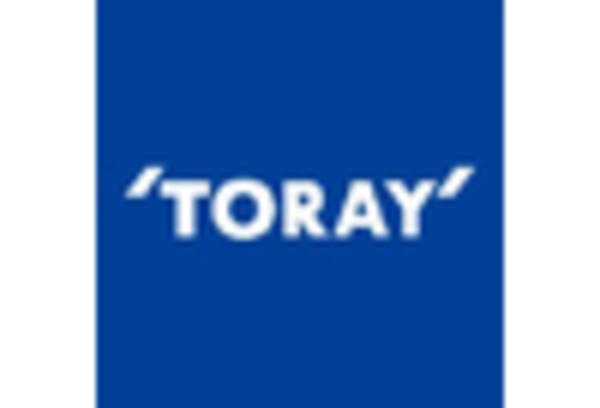-
Executive Summary
-
Scope of the Report
-
Market Definition
-
Scope of the Study
- Research Objectives
- Assumptions & Limitations
-
Markets Structure
-
Market
-
Research Methodology
-
Research Process
-
Secondary Research
-
Primary Research
-
Forecast Model
-
Market Landscape
-
Supply Chain Analysis
-
Market Dynamics of Global High-Temperature Composite Resin Market
-
Raw Type Suppliers
-
Manufacturers/Producers
-
Distributors/Retailers/Wholesalers/E-Commerce
-
End Users
-
Porter’s Five Forces Analysis
- Threat of New Entrants
- Bargaining Power of Buyers
- Bargaining Power of Suppliers
- Threat of Substitutes
- Intensity of Competitive Rivalry
-
Introduction
-
Drivers
-
Restraints
-
Opportunities
-
Challenges
-
Trends/Type
-
Global High-Temperature Composite Resin Market, by
-
Type
-
Introduction
-
Bismaleimides
- Market Estimates &
- Market Estimates & Forecast, by Region,
-
Forecast, 2020−2027
-
Polyimides
- Market Estimates & Forecast,
- Market Estimates & Forecast, by Region, 2020−2027
-
Cyanate Resins
- Market Estimates & Forecast, 2020−2027
- Market Estimates & Forecast, by Region, 2020−2027
-
Phenolic
- Market Estimates & Forecast, 2020−2027
- Market Estimates
-
& Forecast, by Region, 2020−2027
-
Epoxy
- Market Estimates
- Market Estimates & Forecast, by Region,
-
& Forecast, 2020−2027
-
Benzoxazine
- Market Estimates & Forecast,
- Market Estimates & Forecast, by Region, 2020−2027
-
Thermoplastic
- Market Estimates & Forecast, 2020−2027
- Market Estimates & Forecast, by Region, 2020−2027
-
Others
- Market Estimates & Forecast, 2020−2027
- Market Estimates
-
& Forecast, by Region, 2020−2027
-
Global High-Temperature
-
Composite Resin Market, by Manufacturing Process
-
Introduction
- Market Estimates & Forecast, 2020−2027
- Market
-
Layup
-
Estimates & Forecast, by Region, 2020−2027
-
Injection Molding
- Market Estimates & Forecast, 2020−2027
- Market Estimates
-
& Forecast, by Region, 2020−2027
-
Compression Molding
- Market Estimates &
-
Market Estimates & Forecast, 2020−2027
-
Forecast, by Region, 2020−2027
-
Pultrusion
- Market Estimates
- Market Estimates & Forecast, by Region,
-
& Forecast, 2020−2027
-
Filament Winding
- Market Estimates & Forecast,
- Market Estimates & Forecast, by Region, 2020−2027
-
Resin Transfer Molding
- Market Estimates & Forecast, 2020−2027
- Market Estimates & Forecast, by Region, 2020−2027
-
Others
- Market Estimates & Forecast, 2020−2027
- Market Estimates
-
& Forecast, by Region, 2020−2027
-
Global High-Temperature Composite
-
Resin Market, by End-Use Industry
-
Introduction
-
Aerospace and Defense
- Market Estimates & Forecast, 2020−2027
- Market Estimates
-
& Forecast, by Region, 2020−2027
-
Automotive and Transportation
- Market Estimates & Forecast, 2020−2027
- Market Estimates
-
& Forecast, by Region, 2020−2027
-
Electrical and Electronics
- Market Estimates & Forecast, 2020−2027
- Market Estimates
-
& Forecast, by Region, 2020−2027
-
Others
- Market Estimates
- Market Estimates & Forecast, by Region,
-
& Forecast, 2020−2027
-
Global High-Temperature Composite Resin Market, by Region
-
Introduction
-
North America
- Market Estimates & Forecast,
- Market Estimates & Forecast, by Type, 2020−2027
- Market Estimates & Forecast, by Manufacturing Process, 2020−2027
- Market Estimates & Forecast, by End-Use Industry, 2020−2027
- US
-
Market Estimates & Forecast, by Type, 2020−2027
-
& Forecast, by Manufacturing Process, 2020−2027
-
& Forecast, by End-Use Industry, 2020−2027
-
Market Estimates & Forecast, 2020−2027
-
Forecast, by Type, 2020−2027
-
by Manufacturing Process, 2020−2027
-
by End-Use Industry, 2020−2027
-
& Forecast, 2020−2027
-
Market Estimates
-
Market Estimates
-
Canada
-
Market Estimates &
-
Market Estimates & Forecast,
-
Market Estimates & Forecast,
-
Europe
- Market Estimates
- Market Estimates & Forecast, by Type,
- Market Estimates & Forecast, by Manufacturing Process,
- Market Estimates & Forecast, by End-Use Industry,
- Germany
- France
-
Market Estimates & Forecast, by Manufacturing Process, 2020−2027
-
Market Estimates & Forecast, by End-Use Industry, 2020−2027
-
Italy
-
Market Estimates & Forecast, 2020−2027
-
Market Estimates & Forecast, by Type, 2020−2027
-
& Forecast, by Manufacturing Process, 2020−2027
-
& Forecast, by End-Use Industry, 2020−2027
-
Market Estimates & Forecast, 2020−2027
-
Forecast, by Type, 2020−2027
-
by Manufacturing Process, 2020−2027
-
by End-Use Industry, 2020−2027
-
& Forecast, 2020−2027
-
Type, 2020−2027
-
Process, 2020−2027
-
Industry, 2020−2027
-
Forecast, 2020−2027
-
Process, 2020−2027
-
Industry, 2020−2027
-
Forecast, 2020−2027
-
Process, 2020−2027
-
Industry, 2020−2027
-
& Forecast, 2020−2027
-
Type, 2020−2027
-
Process, 2020−2027
-
Industry, 2020−2027
-
Forecast, 2020−2027
-
Market Estimates
-
Market Estimates
-
Spain
-
Market Estimates &
-
Market Estimates & Forecast,
-
Market Estimates & Forecast,
-
UK
-
Market Estimates
-
Market Estimates & Forecast, by
-
Market Estimates & Forecast, by Manufacturing
-
Market Estimates & Forecast, by End-Use
-
Russia
-
Market Estimates &
-
Market Estimates & Forecast, by Type,
-
Market Estimates & Forecast, by Manufacturing
-
Market Estimates & Forecast, by End-Use
-
Poland
-
Market Estimates &
-
Market Estimates & Forecast, by Type,
-
Market Estimates & Forecast, by Manufacturing
-
Market Estimates & Forecast, by End-Use
-
Rest of Europe
-
Market Estimates
-
Market Estimates & Forecast, by
-
Market Estimates & Forecast, by Manufacturing
-
Market Estimates & Forecast, by End-Use
-
Asia-Pacific
- Market Estimates &
- Market Estimates & Forecast, by Type, 2020−2027
- Market Estimates & Forecast, by Manufacturing Process, 2020−2027
- Market Estimates & Forecast, by End-Use Industry, 2020−2027
- China
-
Market Estimates & Forecast, by Type, 2020−2027
-
& Forecast, by Manufacturing Process, 2020−2027
-
& Forecast, by End-Use Industry, 2020−2027
-
Market Estimates & Forecast, 2020−2027
-
Forecast, by Type, 2020−2027
-
by Manufacturing Process, 2020−2027
-
by End-Use Industry, 2020−2027
-
& Forecast, 2020−2027
-
Type, 2020−2027
-
Process, 2020−2027
-
Industry, 2020−2027
-
Estimates & Forecast, 2020−2027
-
by Type, 2020−2027
-
Process, 2020−2027
-
Industry, 2020−2027
-
& Forecast, 2020−2027
-
Type, 2020−2027
-
Process, 2020−2027
-
Industry, 2020−2027
-
& Forecast, 2020−2027
-
Market Estimates
-
Market Estimates
-
India
-
Market Estimates &
-
Market Estimates & Forecast,
-
Market Estimates & Forecast,
-
Japan
-
Market Estimates
-
Market Estimates & Forecast, by
-
Market Estimates & Forecast, by Manufacturing
-
Market Estimates & Forecast, by End-Use
-
Australia & New Zealand
-
Market
-
Market Estimates & Forecast,
-
Market Estimates & Forecast, by Manufacturing
-
Market Estimates & Forecast, by End-Use
-
Rest of Asia-Pacific
-
Market Estimates
-
Market Estimates & Forecast, by
-
Market Estimates & Forecast, by Manufacturing
-
Market Estimates & Forecast, by End-Use
-
Middle East & Africa
- Market Estimates
- Market Estimates & Forecast, by Type,
- Market Estimates & Forecast, by Manufacturing Process,
- Market Estimates & Forecast, by End-Use Industry,
- GCC
-
Market Estimates & Forecast, by Manufacturing Process, 2020−2027
-
Market Estimates & Forecast, by End-Use Industry, 2020−2027
-
Israel
-
Market Estimates & Forecast, 2020−2027
-
Market Estimates & Forecast, by Type, 2020−2027
-
& Forecast, by Manufacturing Process, 2020−2027
-
& Forecast, by End-Use Industry, 2020−2027
-
& Forecast, by Type, 2020−2027
-
by Manufacturing Process, 2020−2027
-
by End-Use Industry, 2020−2027
-
& Forecast, 2020−2027
-
Type, 2020−2027
-
Process, 2020−2027
-
Industry, 2020−2027
-
Market Estimates & Forecast, 2020−2027
-
Forecast, by Type, 2020−2027
-
by Manufacturing Process, 2020−2027
-
by End-Use Industry, 2020−2027
-
& Forecast, 2020−2027
-
Market Estimates
-
Market Estimates
-
North Africa
-
Market Estimates & Forecast, 2020−2027
-
Market Estimates
-
Market Estimates & Forecast,
-
Market Estimates & Forecast,
-
Turkey
-
Market Estimates
-
Market Estimates & Forecast, by
-
Market Estimates & Forecast, by Manufacturing
-
Market Estimates & Forecast, by End-Use
-
Rest of the Middle East & Africa
-
Market Estimates &
-
Market Estimates & Forecast,
-
Market Estimates & Forecast,
-
Latin America
- Market Estimates
- Market Estimates & Forecast, by Type,
- Market Estimates & Forecast, by Manufacturing Process,
- Market Estimates & Forecast, by End-Use Industry,
- Brazil
- Mexico
-
Market Estimates & Forecast, by Manufacturing Process, 2020−2027
-
Market Estimates & Forecast, by End-Use Industry, 2020−2027
-
Argentina
-
Market Estimates & Forecast, 2020−2027
-
Market Estimates & Forecast, by Type, 2020−2027
-
& Forecast, by Manufacturing Process, 2020−2027
-
& Forecast, by End-Use Industry, 2020−2027
-
Estimates & Forecast, by Type, 2020−2027
-
& Forecast, by Manufacturing Process, 2020−2027
-
& Forecast, by End-Use Industry, 2020−2027
-
Market Estimates
-
Market Estimates
-
Rest of Latin America
-
Market Estimates & Forecast, 2020−2027
-
Market
-
Market Estimates
-
Market Estimates
-
Company Landscape
-
Introduction
-
Market Strategy
-
Key Development Analysis
-
(Expansions/Mergers & Acquisitions/Joint Ventures/New Product Developments/Agreements/Investments)
-
Company Profiles
-
Huntsman International LLC
- Company
- Financial Updates
- Product/Business Segment Overview
- Strategy
- Key Developments
- SWOT Analysis
-
Overview
-
Hexcel Corporation
- Company Overview
- Financial Updates
- Product/Business Segment Overview
- Strategy
- SWOT Analysis
-
Key Developments
-
Sumitomo Bakelite Co., Ltd
- Company Overview
- Financial Updates
- Product/Business
- Strategy
- Key Developments
-
Segment Overview
-
SWOT Analysis
-
Koninklijke Ten Cate BV
- Company Overview
- Financial Updates
- Product/Business Segment Overview
- Key Developments
- SWOT Analysis
-
Strategy
-
Hexlon
- Company Overview
- Financial Updates
- Product/Business
- Strategy
- Key Developments
-
Segment Overview
-
SWOT Analysis
-
DIC Corporation
- Company Overview
- Product/Business Segment Overview
- Strategy
- Key Developments
- SWOT Analysis
-
Financial Updates
-
Arkema
- Financial Updates
- Product/Business Segment
- Strategy
- Key Developments
- SWOT Analysis
-
Company Overview
-
Overview
-
Lonza
- Company Overview
- Financial Updates
- Strategy
- Key Developments
- SWOT Analysis
-
Product/Business Segment Overview
-
UBE Industries, Ltd
- Company Overview
- Financial Updates
- Product/Business Segment Overview
- Key Developments
- SWOT Analysis
-
Strategy
-
Evonik
- Company Overview
- Financial Updates
- Strategy
- Key Developments
- SWOT Analysis
-
Industries AG
-
Product/Business Segment Overview
-
Celanese Corporation
- Company Overview
- Financial Updates
- Product/Business Segment Overview
- Strategy
- Key Developments
- SWOT Analysis
-
Conclusion
-
LIST OF TABLES
-
Global High-Temperature
-
Composite Resin Market, by Region, 2020−2027
-
North America:
-
High-Temperature Composite Resin Market, by Country, 2020−2027
-
Table
-
Europe: High-Temperature Composite Resin Market, by Country, 2020−2027
-
Asia-Pacific: High-Temperature Composite Resin Market, by Country, 2020−2027
-
Middle East & Africa: High-Temperature Composite Resin Market,
-
by Country, 2020−2027
-
Latin America: High-Temperature Composite
-
Resin Market, by Country, 2020−2027
-
Global High-Temperature
-
Composite Resin Type Market, by Regions, 2020−2027
-
North America:
-
High-Temperature Composite Resin Type Market, by Country, 2020−2027
-
Table
-
Europe: High-Temperature Composite Resin Type Market, by Country, 2020−2027
-
Table10 Asia-Pacific: High-Temperature Composite Resin Type Market, by Country,
-
Table11 Middle East & Africa: High-Temperature Composite
-
Resin Type Market, by Country, 2020−2027
-
Table12 Latin America: High-Temperature
-
Composite Resin Type Market, by Country, 2020−2027
-
Table13 Global High-Temperature
-
Composite Resin Manufacturing Process Market, by Regions, 2020−2027
-
Table14
-
North America: High-Temperature Composite Resin by Manufacturing Process Market,
-
by Country, 2020−2027
-
Table15 Europe: High-Temperature Composite Resin
-
Manufacturing Process Market, by Country, 2020−2027
-
Table16 Asia-Pacific:
-
High-Temperature Composite Resin Manufacturing Process Market, by Country, 2020−2027
-
Table17 Middle East & Africa: High-Temperature Composite Resin Manufacturing
-
Process Market, by Country, 2020−2027
-
Table18 Latin America: High-Temperature
-
Composite Resin Manufacturing Process Market, by Country, 2020−2027
-
Table19
-
Global High-Temperature Composite Resin End-Use Industry Market, by Regions, 2020−2027
-
Table20 North America: High-Temperature Composite Resin End-Use Industry Market,
-
by Country, 2020−2027
-
Table21 Europe: High-Temperature Composite Resin
-
End-Use Industry Market, by Country, 2020−2027
-
Table22 Asia-Pacific:
-
High-Temperature Composite Resin End-Use Industry Market, by Country, 2020−2027
-
Table23 Middle East & Africa: High-Temperature Composite Resin End-Use
-
Industry Market, by Country, 2020−2027
-
Table24 Latin America: High-Temperature
-
Composite Resin End-Use Industry Market, by Country, 2020−2027
-
Table25
-
Global Type Market, by Region, 2020−2027
-
Table26 Global Manufacturing
-
Process Market, by Region, 2020−2027
-
Table27 Global End-Use Industry
-
Market, by Region, 2020−2027
-
Table28 North America: High-Temperature
-
Composite Resin Market, by Country, 2020−2027
-
Table29 North America:
-
High-Temperature Composite Resin Market, by Type, 2020−2027
-
Table30 North
-
America: High-Temperature Composite Resin Market, by Manufacturing Process, 2020−2027
-
Table31 North America: High-Temperature Composite Resin Market, by End-Use
-
Industry, 2020−2027
-
Table32 Europe: High-Temperature Composite Resin
-
Market, by Country, 2020−2027
-
Table33 Europe: High-Temperature Composite
-
Resin Market, by Type, 2020−2027
-
Table34 Europe: High-Temperature Composite
-
Resin Market, by Manufacturing Process, 2020−2027
-
Table35 Europe: High-Temperature
-
Composite Resin Market, by End-Use Industry, 2020−2027
-
Table36 Asia-Pacific:
-
High-Temperature Composite Resin Market, by Country, 2020−2027
-
Table37
-
Asia-Pacific: High-Temperature Composite Resin Market, by Type, 2020−2027
-
Table38 Asia-Pacific: High-Temperature Composite Resin Market, by Manufacturing
-
Process, 2020−2027
-
Table39 Asia-Pacific: High-Temperature Composite
-
Resin Market, by End-Use Industry, 2020−2027
-
Table40 Middle East &
-
Africa: High-Temperature Composite Resin Market, by Country, 2020−2027
-
Table41 Middle East & Africa: High-Temperature Composite Resin Market, by
-
Type, 2020−2027
-
Table42 Middle East & Africa: High-Temperature Composite
-
Resin Market, by Manufacturing Process, 2020−2027
-
Table43 Middle East
-
& Africa: High-Temperature Composite Resin Market, by End-Use Industry, 2020−2027
-
Table44 Latin America: High-Temperature Composite Resin Market, by Country,
-
Table45 Latin America: High-Temperature Composite Resin Market,
-
by Type, 2020−2027
-
Table46 Latin America: High-Temperature Composite
-
Resin Market, by Manufacturing Process, 2020−2027
-
Table47 Latin America:
-
High-Temperature Composite Resin Market, by End-Use Industry, 2020−2027
-
LIST OF FIGURES
-
Global High-Temperature Composite Resin Market
-
Segmentation
-
Forecast Research Methodology
-
Five Forces
-
Analysis of Global High-Temperature Composite Resin Market
-
Value Chain
-
of Global High-Temperature Composite Resin Market
-
Share of Global
-
High-Temperature Composite Resin Market in 2020, by Country (%)
-
Global
-
High-Temperature Composite Resin Market, 2020−2027
-
Global High-Temperature
-
Composite Resin Market Size, by Type, 2020
-
Share of Global High-Temperature
-
Composite Resin Market, by Type, 2020−2027
-
Global High-Temperature
-
Composite Resin Market Size, by Manufacturing Process, 2020
-
Share
-
of Global High-Temperature Composite Resin Market, by Manufacturing Process, 2020−2027
-
Global High-Temperature Composite Resin Market Size, by End-Use Industry,
-
Share of Global High-Temperature Composite Resin Market, by
-
End-Use Industry, 2020−2027

















Leave a Comment